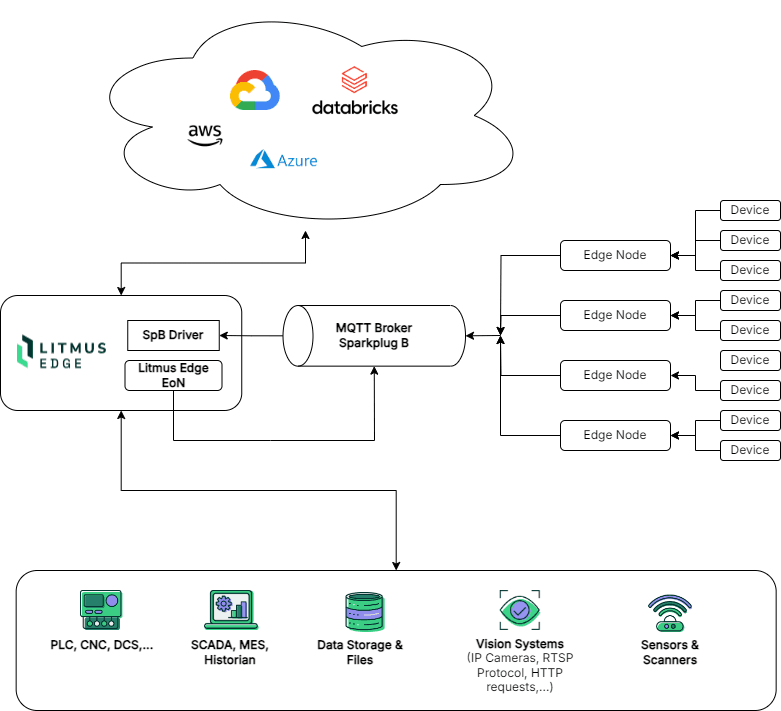Parth Desai
Founding Engineer & Director of Solutions & Industrials
From Humble Beginnings to a Cutting-Edge Innovation Center
In a major improvement to industrial connectivity, Litmus Edge introduced a new feature, incorporating Sparkplug B to boost device communication. This upgrade heralds a new era in standardized data protocols, enhancing industrial operations.

In a significant enhancement to industrial connectivity and data management, Litmus has unveiled a new feature in Litmus Edge, designed to streamline and fortify communication between devices in an industrial setting. By integrating the Sparkplug B specification, Litmus Edge positions itself as a cornerstone in the advancement of standardized and efficient data communication protocols across the sector.
Sparkplug B, a specification popular in the process industry, is designed to improve MQTT broker communication for devices and applications by ensuring seamless, standardized data across networks. Its significant advantage lies in simplifying device communication and easing integration challenges, particularly in environments like the process industry where numerous sensors and devices require robust, real-time connectivity.
Last year, we had published a Litmus Edge Solution Accelerator, LE Sparkplug Edge Node, which enabled Litmus Edge to function as a Sparkplug Edge Node. In a Sparkplug system, an Edge of Network (EoN) node, commonly referred to as a Sparkplug edge node, serves as the crucial link between end devices and the MQTT broker. This intermediary device or gateway facilitates the pivotal role of managing and relaying communications within the Sparkplug network. This solution was aimed at simplifying the integration and interoperability of devices and applications of different vendors. The Solution Accelerator is available for download in the Litmus Central Portal.
Check out the documentation to learn how to deploy this solution.
In its latest update, Litmus Edge can now act as a highly compatible end-application capable of consuming and managing data via a Sparkplug B enabled MQTT broker. In this setup, Litmus Edge not only reads data transmitted by various nodes (such as sensors and devices) but also publishes this data to northbound sources—be it cloud platforms or OT/IT systems.
To summarize, Litmus Edge can now not only function as the interlink in a Sparkplug enabled infrastructure, but also provide the industrial data processing and management capabilities – making unified, scalable industrial data operations a reality in a Sparkplug system.
Setting up the Sparkplug B client within Litmus Edge is streamlined to enhance user experience. Users simply input a name, description, and client ID, configure the MQTT broker's address and port, and choose from numerous authentication options including certifications and usernames. Additionally, they can set the namespace—a crucial part of the MQTT topic structuring, which remains aligned with Sparkplug 3.0 specifications, allowing for future adaptations like potential changes in Sparkplug 4.0.
Check out our documentation for a step-by-step guide.
Litmus Edge users are empowered to seamlessly browse tags from devices connected to the system and cherry-pick specific metrics to monitor or analyze. This capability is bolstered by the integration of tags directly within the Litmus Edge Analytics component. The standout aspect, though, is the sophisticated transformation of Sparkplug B NDATA and DDATA payloads into a universally recognized JSON format. This strategic parsing enriches the data, providing it with added layers of context and meaning. As a result, the platform ensures the data is not just transit-ready for external systems or cloud services, but also much more insightful and valuable for making informed decisions before pushing the data to these systems.
Litmus Edge will also support NBIRTH, DBIRTH, NDEATH, and DDEATH payloads. These functionalities enable Litmus Edge users to automatically detect and understand what nodes, devices, and metrics are available from the broker. This greatly simplifies the management of devices and their lifecycle, facilitating better real-time monitoring and control of industrial processes.
Litmus Edge's incorporation of Sparkplug B responds directly to customer demands for more connectivity options within industrial settings. Customers who have already implemented this protocol, especially in the process industry, can now leverage Litmus Edge for smarter and standardized data management practices. This solution fits seamlessly into processes where sensors communicate via MQTT, simplifying system setup and data visibility.
A particular advantage Litmus Edge offers over similar tools is its advanced capability in handling detailed data transformation and transmission. Unlike other systems where additional modules might be required to bridge data to cloud services, Litmus Edge integrates cloud connectivity natively. It provides additional metadata and contextualization to the data collected, offering more detailed insights and value than typically afforded by basic Sparkplug B configurations.
As industries continue to evolve and demand more from their technological investments, solutions like Litmus Edge are set to play a pivotal role in defining the future of industrial connectivity and data intelligence.
This development not only simplifies the technological landscape but also opens new avenues for data optimization and system integration in various industries, particularly those reliant on process controls and automation.
Try Litmus Edge today or speak with our team of experts about your unique requirements.
Parth Desai
Founding Engineer & Director of Solutions & Industrials
Parth Desai is a Founding Engineer and heads the Industrial and Solutions team at Litmus.
Parth Desai
Founding Engineer & Director of Solutions & Industrials
From Humble Beginnings to a Cutting-Edge Innovation Center
Parth Desai
Founding Engineer & Director of Solutions & Industrials
Here at Litmus, there is a common theme in the feedback we receive from our customers. How can I make sense of my raw industrial data, with all its inconsistencies and variabilities, even among identical machines on the same production line?
Parth Desai
Founding Engineer & Director of Solutions & Industrials
IT teams and digital transformation advocates will find the Syslog Server connector in Litmus Edge particularly beneficial for its ability to effortlessly merge IT & OT data streams, improving real-time decision-making across intricate networked systems.